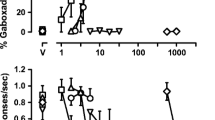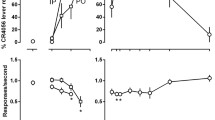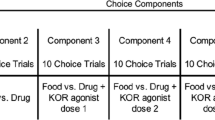Abstract
Rationale. The discriminative effects of κ-agonists may be mediated centrally, whereas their effects in a neuroendocrine biomarker assay (prolactin release) may be mediated by κ-receptors in hypothalamic areas outside the blood-brain barrier. Prolactin may thus be a useful biomarker, due to its potential to provide quantitative pharmacodynamic data for κ-opioid ligands in vivo. The potency of centrally penetrating κ-agonists could be similar in these two assays, due to their ability to occupy κ-receptor pools inside and outside the blood-brain barrier, following SC administration.
Objective. To compare the potency of centrally penetrating κ-agonists in producing U69,593-like discriminative stimulus effects (U69,593 is considered a selective κ-agonist), and in producing prolactin release in rhesus monkeys.
Methods. Cumulative dose-effect curves of κ-agonists (R84760, bremazocine, spiradoline and U50,488) were investigated in a food-reinforced U69,593 discrimination (n=3), and compared to those for the µ-opioids fentanyl and nalbuphine and the δ-agonist SNC80. Selected κ-opioids (R84760 and spiradoline) were compared to fentanyl, nalbuphine and SNC80 in the neuroendocrine biomarker assay, in intact female rhesus monkeys (n=4).
Results. All the selective κ-agonists caused dose-dependent generalization (i.e. at least 90% drug-appropriate responding) in the U69,593 discriminating subjects, and caused robust, dose-dependent prolactin release in female rhesus monkeys. By contrast, fentanyl, nalbuphine and SNC80 did not cause generalization in these subjects. Fentanyl and nalbuphine also caused prolactin release; quantitative antagonism (apparent pKB) experiments following nalmefene (0.01, 0.1 mg/kg) differentiated the effects of a selective κ-agonist (spiradoline) from those of a selective µ-agonist (fentanyl). A positive correlation (r=0.99) was noted between the mean log ED50 of κ-agonists in the discrimination and neuroendocrine assays, from these and previous determinations.
Conclusions. The potency of centrally penetrating κ-agonists in causing their neuroendocrine effects is similar to their potency in causing discriminative effects. Furthermore, apparent pKB experiments with nalmefene differentiated the receptor mediation (i.e. κ or µ) of these compounds in the neuroendocrine biomarker assay.
Similar content being viewed by others
Author information
Authors and Affiliations
Additional information
Electronic Publication
Rights and permissions
About this article
Cite this article
Butelman, E.R., Ball, J.W. & Kreek, MJ. Comparison of the discriminative and neuroendocrine effects of centrally penetrating κ-opioid agonists in rhesus monkeys. Psychopharmacology 164, 115–120 (2002). https://doi.org/10.1007/s00213-002-1195-y
Received:
Accepted:
Issue Date:
DOI: https://doi.org/10.1007/s00213-002-1195-y




